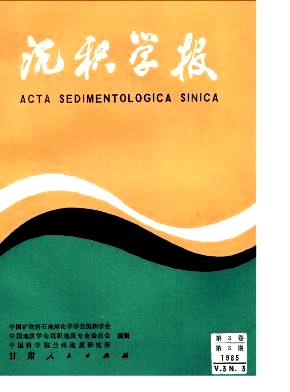STUDY ON REDESTRUCTION AND RETRANSFOR- MATION TRACES OF GRAVELS
- Received Date: 1984-02-11
- Publish Date: 1985-09-10
Abstract: The paper covers three aspects to redestuction and retransformation traces of quartz gravels. 1 Redestruction and retransformation traces result inevitablly from various geological actions after gravel accumulation. The non-transformed redestraction gravel is named by. the authors the Q-Q gravel, which is characterised by obvious destruction traces ( e. g. rift, etc. ) , scratchs on the surface and sharp edges without bluntness or roundness ( Fig. 2 ). After another geological action, if the sharp edge of the Q-Q gravel is abraded and becomes blunt or round, showing a. trace of retransformation, this type of gravels is named the Q-D gravel ( Fig. 4 ) . However, if there is no abrasion or an obviously partial abrasion with the original shape remained, it is named the Q-O gravel ( Fig. 1 3 ). Based on these st udies, it is found that the geological actions causing redestruction and retranstormation are tectonic movement, driftbed, glacial erosion, glacial split and scion action of plant roots, etc..The tectonic movement and driftbed are the main factions of redestruction and retransformation. 2 In the Quaternary sediment of the ancient Yishu River area, different types of quartz gravels of redestruction and retransformation are counted and the result shows in Table 1 and Fig. 1 . From which it is obviously that there are some changes in the gravel content of different types of the Upper, Middle and Low Pleistocene strata and with a triangle diagram ( Fig. 1 ) the authors .probed into the possibility of using the points and link lines of the OD-QD to determine the border between the Middle Pleistocene aad the Low Pleistocene. 3 Along with redestruction and retransformation, a great quantity of unstable materials in strata are eroded and the volumn of strata are rapidly reduced while the content of stable materials are relatively increased. Thus, the ore tenor of stable and valuble minerals is also correspondingly increased. By this way. in this ditrict are formed diamond sand deposits with the industrial value. According to the above studies, the authors have drown up a genesis model of diamond sand deposits ( Fing. 3 ) and based on the model the possibles research direction to diamond sand deposits in this district is given.
| Citation: | Van Fenglin, Zhu Mingshan. STUDY ON REDESTRUCTION AND RETRANSFOR- MATION TRACES OF GRAVELS[J]. Acta Sedimentologica Sinica, 1985, 3(3): 87-94. |






 DownLoad:
DownLoad: